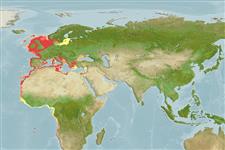Common names from other countries
Environment: milieu / climate zone / depth range / distribution range
Ekologi
; kisaran kedalaman 0 - 242 m (Ref. 1695), usually 0 - 50 m (Ref. 88010). Tropical, preferred 21°C (Ref. 107945); 62°N - 4°N, 32°W - 37°E (Ref. 1695)
Eastern Atlantic and the Mediterranean: from the Shetlands and southern Norway (stray in the Baltic Sea), south to the Mediterranean Sea to northwestern Africa.
Length at first maturity / Size / Weight / umur
Maturity: Lm ?, range 9 - ? cm Max length : 49.0 cm ML jantan/; (Ref. 1695); Berat maksimum terpublikasi: 4.0 kg (Ref. 1695)
In temperate waters, maximum mantle length is 49 cm and up to 4 kg in weight. In the subtropics, maximum mantle length is 30 cm and up to 2 kg in weight (Ref. 1695). Common size: 15.0 to 25.0 cm (West Saharan fisheries; Ref. 275). One of the most important species for cephalopod fisheries in many countries but have been observed in recent years that it is heavily fished, e.g., Mediterranean (Ref. 1695). Also, a highly valued item especially in Japan, Korea, Italy and Spain (Ref. 1695). Maximum depth range from Ref. 114857. A neritic, demersal species found in the subtidal zone to depths of 200 m, generally over sandy-muddy substrates (Ref. 1695, page 100). Presence in Portuguese waters indicates its tolerance for brackish water. Undegoes seasonal migrations between inshore waters in spring and summer and medium shelf grounds (around 100 m depth) in autumn and winter. Courtship behavior is elaborate and ritualized with visual displays and 'mate guarding'. Spawns in shallow waters, optimally between 13° to 15°C. Eggs, 8 to 10, mm diameter and blackened with ink, are attached on seaweed, shells, debris and other substrates, in grape-like clusters. Depending on water temperature, eggs hatch after 30 to 90 days. Hatchlings measure about 7 to 8 mm TL. From hatchlings to adults, exhibit light-induced burying behavior where most individuals hide in sand during the day and where prey is often ambushed. Life cycle under natural conditions, between 12 to 24 months. Feeds on small molluscs, crabs, shrimps, other cuttlefishes, and juvenile demersal fishes. Cannibalism is common. Considered one of the most commercially important cephalopod species. With potential for aquaculture. Usually marketed fresh or frozen as a highly valued food item, especially in Japan, Korea, Italy and Spain (Ref. 1695).
Male and female adults usually die shortly after spawning and brooding, respectively. Mating behavior: Males perform various displays to attract potential females for copulation. During copulation, male grasp the female and inserts the hectocotylus into the female's mantle cavity where fertilization usually occurs. Life cycle: Embryos hatch into planktonic stage and live for some time before they grow larger and take up a benthic existence as adults (Ref. 833).
rujukan utama
Acuan | Koordinator | mitra
Schneider, W. 1990. (Ref. 417)
Status IUCN Red List (Ref. 130435)
status CITES (Ref. 108899)
Not Evaluated
Not Evaluated
penggunaan manusia
Perikanan: komersial
FAO - Budidaya air: production; Perikanan: landings, profail spesis | FIRMS (Stock assessments) | FishSource | Sea Around Us
Alat, peralatan
Sumber internet
Estimates based on models
Preferred temperature
(Ref.
115969): 8.4 - 19.7, mean 11.3 (based on 1048 cells).
Daya lenting
Tinggi, Waktu penggandaan populasi minimum kurang dari 15 bulan (K=0.58-0.63; tm=1).
Prior r = 0.50, 95% CL = 0.33 - 0.76, Based on 3 full stock assessments.
keancaman
Low to moderate vulnerability (30 of 100).
